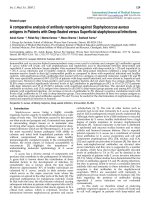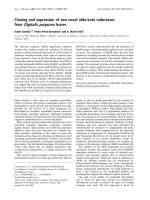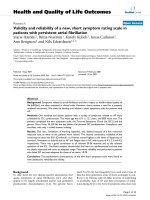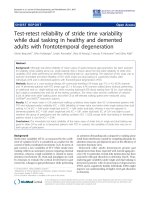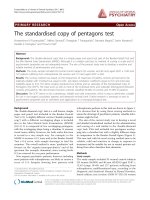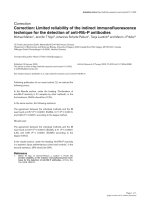Báo cáo y học: " Test - retest reliability of two instruments for measuring public attitudes towards persons with mental illness" ppsx
Bạn đang xem bản rút gọn của tài liệu. Xem và tải ngay bản đầy đủ của tài liệu tại đây (209.01 KB, 6 trang )
RESEARCH ARTICLE Open Access
Test - retest reliability of two instruments for
measuring public attitudes towards persons
with mental illness
Bengt Svensson
1*
, Urban Markström
2
, Ulrika Bejerholm
1
, Tommy Björkman
1
, David Brunt
5
, Mona Eklund
1
,
Lars Hansson
1
, Christel Leufstadius
1
, Amanda Lundvik Gyllensten
1
, Mikael Sandlund
3
, Margareta Östman
4
Abstract
Background: Research has identified stigmatization as a major threat to successful treatment of individuals with
mental illness. As a consequence several anti-stigma campaigns have been carried out. The results have been
discouraging and the field suffers from lack of evidence about interventions that work. There are few reports on
psychometric data for instruments used to assess stigma, which thus complicates research efforts. The aim of the
present study was to investigate test-retest reliability of the Swedish versions of the questionnaires: FABI and
“Changing Minds” and to examine the internal consistency of the two instrume nts.
Method: Two instruments, fear and behavioural intentions (FABI) and “Changing Minds”, used in earlier studies on
public attitudes towards persons with mental illness were translated into Swedish and completed by 51 nursing
students on two occasions, with an interval of three wee ks. Test-retest reliability was calculated by using weighted
kappa coefficient and internal consistency using the Cronbach’ s alpha coefficient.
Results: Both instruments attain at best moderate test-retest reliability. For the Changing Minds questionnaire
almost one fifth (17.9%) of the items present poor test-r etest reliability and the alpha coefficient for the subscales
ranges between 0.19 - 0.46. All of the items in the FABI reach a fair or a moderate agreement between the test
and retest, and the questionnaire displays a high internal consistency, alpha 0.80.
Conclusions: There is a need for development of psychometrically tested instruments within this field of research.
Background
Negative public attitudes towards persons suffering from
mental illness have been identified as an obstacle for
recovery from illness and becoming full participants in
society [1]. The concept of stigmatization has been
described and operationa l definitions have been made
by various researchers [2]. Although there is no clear
consensus, stigmat ization of people with mental illness
is usually described as a complex of problems emanating
from a lack of knowledge about mental health problems,
negative attitudes and excluding or avoiding behaviours
towards individuals suffering from mental heal th pro-
blems. For those who are subjected to stigma and their
relativesthisleadstoaperceptionofthepublicas
ignorant, prejudiced and discriminating in their view of
mental illness [1].
It has been shown that stigmatization reduces life
chances for persons suffering from mental illness. The
negative effects include less access to mental health ser-
vices and to advances in psychiatric treatment [3,4], to
psychosocial stress, to low socio-economic status and to
delay in appropriate help seeking [5]. Relatives of men-
tally ill persons identify stigma as a key problem that
causes their ill relatives a lowered self-esteem, difficulties
in making and keeping friends, and a tendency to deny
that they have a mental illness [6]. The relat ives also
experience burden due to the stigma associated with
mental illne ss. In a study investigating family stigma one
group of relatives reported thoughts of life and death in
terms of their relatives and themselves. Eighteen per
* Correspondence:
1
Department of Health Sciences, Lund University, PO Box 157 221 00 Lund,
Sweden
Full list of author information is available at the end of the article
Svensson et al. BMC Psychiatry 2011, 11:11
/>© 2011 Svensson et al; licensee BioMed Central Ltd. This is an Open Access article distributed under the terms of the Creative
Commons Attribution License ( which permits unrestri cted use, distribution, and
reproduction in any medium, provided the original work is properly cited.
cent of the relatives had sometimes felt that the patient
would have been better off dead. Ten per cent o f the
family members in the same stud y reported that they
now and then had experienced suicidal thoughts [7].
Persons w ith a diagnosis of mental disorder also pre-
sent difficulties in seeking and keeping work. In a
study of people suf fering from schizophrenia in five
European countries the employment rate ranged from
5% (England) to a maximum of 23% (Italy) [8]. One
explanation for the low employment rate is that
employers discri minate a gainst persons w ho have a
history of psychiatric treatment. In a study of 200
Human Resource Officers in UK companies it was
shown that a history of mental illness significantly
reduced the chances of employment in comparison
with a history o f diabetes [9]. Two studies in California
found that employers perceived people with mental ill-
ness as being as undesirable as ex-convicts and that
the only group they were more reluctant to hire were
people with active tuberculosis [10].
To suffer from mental health problems also leads in
many cases to a process of identity transformation
where persons lose their previously held or desired iden-
tities and adopt a stigmatised view of themselves. This
process is referred to as self-stigma [11], internalised
stigma [12] or anticipated stigma [13]. Self-stig ma has
been associated with reductions in protective psycholo-
gical variables such as hope [14], self-esteem [15,16],
self-efficacy [17], empowerment [17,18] and recovery
beliefs [18]. It is also associated with lower quality of life
[15,17] and an increase in avoidant coping strategies
such as withdrawal and secrecy.
Several programs to fight stigma have been initiated as
a consequence of the research findings that have indi-
cated stigmatization as a threat to successful treatment
and rehabilitation of individuals with mental illness.
Some of these programs have been international, such
as the World Psychiatric Association’ s Global Pro-
gramme against Stigma and Discrimination because of
Schizophrenia [19], others have been national such as
the Changing Minds Campaign by the Royal College of
Psychiatrists in the United Kingdom [20,21], the
PSYKE-Campaign in Sweden [22] and the National
Mental Health charity SANE Australia [23]. The overall
ambitions have been to increase public knowledge about
mental illness and its treatment possibilities, to create
more positive attitudes towards people with mental ill-
ness and to reduce prejudice and discrimination. To
some extent the aims of these campaigns have been
achieved [19,24]. However, despite all efforts to reduce
stigma through public campaigns the results are not
convincing and the field suffers from a lack of evidence
about what works [1]. The process appears to be a slow
one. In a recent study 73% of a cohort of persons
suffering from mental illness believed that most employ-
ers would pass over an application from a former psy-
chiatric patient in favour of another applicant and that
they are not considered as trustworthy as the average
citizen (67%) or as intelligent as other people (56%)
[25]. In another recent study a list of 250 der ogatory
labels used among four teen year old schoolc hildren to
stigmatize people with mental illness were described.
The authors suggest that this wide-rang ing and negative
number of terms about mental illness appears to ema-
nate from the media and from family and peers [26]. All
these findings indicate a quite persistent negative atti-
tude in the general population.
There is a need for further work in the struggle
against stigma and valid and reliable instruments need
to be tested in order to measure effects of interventions.
Link et al [27] have reviewed different methods for
measur ing mental health stigma but there is little infor-
mation about psychometric properties of the instru-
ments used in the various studies. There is often
information about the internal consistency of the differ-
ent scales but nothing about their test-retest reliability.
The reliability in this respect is crucial when using the
scales to evaluate the rate of success associated with dif-
ferent interventions. The present study was carried out
to determine psychometric properties of two instru-
ments used in earlier studies. The instruments chosen
were: “ The self-report inventory of fear of a nd beha-
vioural intentions toward the mentally ill (FABI) [28,29]
and the set of questions used in the campaign “ Chan-
ging Minds: Every Family in the L and” initiated by the
Royal College of Psychiatrists [20]. The purpose was to
create Swedish versions of instruments that could be
used in research on attitudes towards persons with
mental illness. Being as no data concerning psycho-
metric properties concerning these scales have been
presented it is important to conduct a trial t o establish
this information.
Aims
The aims of the study were:
- to investigate test-retest reliability of the Swedish
versions of the self-report inventory: FABI and of
the “Changing Minds"- questionnaire
- to examine the internal consistency of the two
instruments
Methods
Permission to translate the instrume nts was obtained
from the original authors. The instruments were first
translated into Swedish and then retranslated into Eng-
lish. The language in the different versions were com-
pared and adjusted to the final Swedish versions.
Svensson et al. BMC Psychiatry 2011, 11:11
/>Page 2 of 6
The questionnaires
Theself-reportinventoryoffearofandbehavioural
intentions toward the mentally ill (FABI) is a ten item
questionnaire with a five point response scale for eac h
question. Responses are coded from 1 to 5 and the
items include:
Fear: (response al ternatives: strongly agree, agree, neu-
tral, disagree and strongly disagree)
“I am afraid of people with mental illness”
Behavioural intentions: (response alternatives: ve ry
likely, likely, uncertain, unlikely, very unlikely)
“Would you object to hav ing m entally ill people living
in your neighbourhood?”
“Would you avoid conversations with neighbours wh o
had suffered from mental illness?”
“Would you be willing to work with somebody with a
mental illness?”
“Would you invite somebody into your home if you
knew they suffered from mental illness?”
“Would you be wor ried about visiting somebody with
a mental illness?”
“If somebody had been a former psychiatric patient,
would you have them as a friend?”
“ If somebody who had been a former psychiatric
patient came to live next door to you, would you greet
them occasionally?”
“ Would you have casual conversations with neigh-
bours who had suffered from mental illness?”
“ If somebody who had been a former psychiatric
patient came to live next door to you, would you visit
them?” [28,29]
Changing Minds: Every family in the Land
The instrum ent was, in the original study, administered
as an interview and two sets of data were obtained [20].
The first set collected data about household composition
and individual demographic and employment-related
circumstances. This set w as not used in the present
study. The second set was designed to obtain percep-
tions about seven mental disorders, identified in pre-
interview focus groups and then targeted by the Royal
College of Psychiatrists campaign. The focus groups had
indicated that these disorders were familiar to the gen-
era l publ ic. The d isorders were severe depression, pan ic
attacks, schizophrenia, dementia, eating disorders, alco-
holism and drug addiction. The questions about the dis-
orders were based on findings presented in a literature
review on stigmatization of people with mental disorders
by Hayward and Bright [30]. The key perceptions of
persons with mental illness are that they are dangerous,
unpredictable, are difficul t to talk with, have only them-
selves to blame, are able to pull themselves together,
have a poor outcome and don’t respond very much to
treatment according to this review. For each disorder
the respondents could rank their perception on a five
point scale from one extreme e.g. “dangerous to others”,
to the opposite, “not dangerous to others”, “unpredict-
able” to “not unpredictable” and so forth. In the present
study the questions were administered as a self-rating
questionnaire. Information about the activities and the
evaluation of the “ Changing minds” campaign can be
found on the website: />paigns/previouscampaigns/changingminds.aspx
Sample and Data collection
The sample consisted of 51 students in a three year edu-
cational programme in nursing. They were in their sec-
ond semester and during the data collect ion pe riod they
were studying physiology and anatomy. Nothing in their
present education had, to our knowledge, a content that
could affect their view of mental disorders. The first
data collection was made in September, 2007 and the
retest data collection was made three weeks later. No
major media discussions concerning mental illness
occurred during the time period between the test and
retest data collection. Being as this investigation is a
part of a larger study concerning the impact of formal
education in psychiatry on attitudes towards mental i ll-
ness baseline data from a large r database was used to
examine internal consistency. This larger database con-
sisted of 1001 students from e ducational programmes
including psychiatry in their curri culum. The following
student categories were represented: nursing, medicine,
social work, physiotherapy, occupational therapy, psy-
chology, public health work, and police trainee.
Statistics
Weighted kappa coefficients were calculated for each
item in the two questionnaires in order to investigate
the test - retest reliability for the different instruments.
The reference values for the strength of agreement are
from Altman [31] who consid ers < 0.20 as poo r agree-
ment, 0.21-0.40 as fair, 0.41-0.60 as moderate, 0.61-0.80
as good and 0.81-1.00 as a very good agreement.
Weighted kappa is used be cause it takes into acco unt
the magnitude of the discrepancy in ordinal data.
A w eakness of ordinary kappa statistics is that it t reats
all disagreem ents equally whether they are very large or
very small [31]. Internal consistency was examined by
calculating Cronbach’s alpha co efficient for the FABI. In
the questionnaire from the Changing Minds campaign
the Cronbach’s alpha coefficient was calculated for the
responses concerning each disord er. The statistical soft-
ware used was SPSS 15.0 and Vasserstats [32].
Ethical considerations
In accordance with Swedish legislation research that not
includes interventions does not require formal approval
Svensson et al. BMC Psychiatry 2011, 11:11
/>Page 3 of 6
from a research ethic committee. The methods of eva-
luation conformed to the Helsinki Declaration.
Results
The results from the “Changing minds” questionnaire
display at best a moderate agreement between the test
and retest. The items concerning unpredictability and
whether it is difficult or not to talk to a person with a
certain d isorder appear in particular to have low test-
retest reliability. The calculation of Cronbach’ salpha
shows that none of the batteries of questions about the
different disorders has a sufficient level of internal con-
sistency in order to be considered as scales (table 1).
The complete “ Changing minds” questionnaire con-
sistsof56itemsand10ofthese(17.9%)presentpoor
test-retest reliability, 26 items (46.4%) fair and finally 20
items (35.7%) moderate test-retest reliability.
The weighted kappa values for the self-report inve n-
tory of fear and behavioural intentions towards the men-
tally ill (FABI) also attain at best moderate test-retest
reliability. H owever, none of the items fall below a fair
agreement level between the test and retest. The ques-
tionnaire shows high internal consistency (table 2).
Discussion
The investigation of the test-retest reliability in attitudes
towards the mentally ill during a three week period indi-
cates a certain level of instability in attitudes as mea-
sured with the “ Changing minds” questionnaire and
FABI. The sample consisted of nursing students study-
ing in their first year o f the educat ional programme . No
demographicdataforthegroupinvestigatedwascol-
lected but a fair estimation is that it consists of a major-
ity of females with a stable middle class background and
with a mean age between 20 an d 25. They can thus not
be considered to be representative for any group other
than nursing students. There are, however, no plausible
hypotheses that state that a group consisting of a major-
ityofyoungwomenshouldbemoreinconsistentin
their attitudes than any other group. The fact that the
students were trainees in a helping pr ofession might be
of interest. If they, after the first completion of the ques-
tionnaire, became interested in the issues presented and
found out more about these then this may have contrib-
uted to a change in their attitudes. Though, health care
professionals have in several studies shown attitudes
even less favourable than members of the general public
[33-35].
Comparisons are difficult to make being as no pre-
vious psychometric data for the instruments have been
published. The internal consistency reliability of scales
measuring social distance tends to be good or excellent
[27], which is also repeated for the self-report inventory
of fear of and behavioural intentions towards the men-
tally ill (FABI) in the present study. The questions in
FABI deal with intentions that to a high degree reflect
social distance, so in that respect the results are quite
consistent with earlier findings.
The “Changing minds” questionnaire displays poor
internal consistency reliability and rather problematic
overall test-retest reliability. This is quite unexpected;
the scale has high face validity and is based on ambi-
tious research [20]. A similar technique to construct
questionnaires was used by Olmsted and Durham [36].
They studied attitudes among college students towards
the mentally ill using a scale containing pairs of adjectives
representing opposites, such as “ valuable - w orthless,
clean - dirty, predictable - unpredictable, etcetera”.The
results from analyses of three different cohorts, sociology
students from 1962, from 1971 and a stratified sample of
“general public” show a very high correlation in attitudes
between both groups and time points. This indicates a
high stability in attitudes at a group level. Whether this
also mirrors high test-retest reliability cannot be deduced
Table 1 Weighted kappa and Cronbach alfa for the “Changing minds” questionnaire (95%Cls), (n = 51)
Opinion Type of mental illness
Severe
depression
Panic attacks Schizophrenia Dementia Eating
disorder
Alcohol
addiction
Drug
addiction
Danger to others 0.18 (0.01-0.36) 0.32 (0.14-0.51) 0.41 (0.21-0.61) 0.43 (0.27-0.60 0.32 (0.00-0.66) 0.17 (0.01-0.33) 0.25 (0.07-0.43)
Unpredictable 0.05 (0-0.22) 0.34 (0.14-0.53) 0.33 (0.08-0.58) 0.24 (0.05-0.42) 0.20 (0.00-0.41) 0.12 (0.00-0.30) 0.37 (0.18-0.57)
Hard to talk to 0.13 (0.00-0.35) 0.20 (0.02-0.39) 0.18 (0.00-0.38 0.42 (0.22-0.62) 0.27 (0.09-0.46) 0.27 (0.07-0.46) 0.31 (0.13-0.49)
Selves to blame 0.43 (0.25-0.62) 0.36 (0.17-0.55) 0.35 (0.14-0.55) 0.58 (0.29-0.86) 0.60 (0.46-0.74) 0.52 (0.34-0.70) 0.48 (0.31-0.66)
Not improved if
treated
0.28 (0.04-0.52) 0.19 (0.00-0.45 0.48 (0.33-0.64) 0.38 (0.20-0.55) 0.23 (0.03-0.42) 0.12 (0.00-0.32) 0.44 (0.24-0.63)
Feel different 0.35 (0.15-0.55) 0.42 (0.23-0.62) 0.52 (0.27-0.77) 0.42 (0.18-0.65) 0.45 (0.24-0.65) 0.40 (0.22-0.58) 0.49 (0.29-0.68)
Pull self together 0.51 (0.32-0.69) 0.43 0.26-0.61) 0.38 (0.18-0.57) 0.32 (0.07-0.57) 0.42 (0.25-0.60) 0.45 (0.28-0.61) 0.31 (0.13-0.50)
Never recover 0.26 (0.08-0.45) 0.47 (0.23-0.71) 0.31 (0.12-0.49) 0.22 (0.02-0.42) 0.43 (0.18-0.69) 0.32 (0.12-0.52) 0.28 (0.18-0.56)
Cronbach alfa 0.26 0.40 0.27 0.21 0.19 0.41 0.46
Weighted kappa, < 0.20 poor agreement, 0.21-0.40 fair, 0.41-0.60 moderate, 0.61-0.80 good, 0.81-1.00 very good (Altman, 1991).
Svensson et al. BMC Psychiatry 2011, 11:11
/>Page 4 of 6
due to the lack of data. The fact that the “Chang ing
minds” questionnaire was used as a self-rating instrument
and the information in the original studies was obtained
through interviews might make a difference. It is, however,
difficult to imagine the potential significance of this differ-
ence being as no comparable data exist. The research of
stigma towards the mentally ill has increased and a num-
ber of different instru ments are in use [27]. F urther
resear ch is thus needed to create psychometrically sound
instruments for securing valid and reliable results.
Conclusion
Psychometrically tested instruments for measuring public
attitudes towards persons with mental illness are generally
lacking. The present study indicates low test-retest reliabil-
ity for the two scales investigated. To ensure the use fulness
of further research within this particular research field a
development of reliable and vali d measurements is needed.
Author details
1
Department of Health Sciences, Lund University, PO Box 157 221 00 Lund,
Sweden.
2
Department of social work, Umeå University 901 87 Umeå,
Sweden.
3
Department of clinical sciences/Psychiatry, Umeå University 901 85
Umeå, Sweden.
4
Faculty of Health and Society Malmö University 205 06
Malmö, Sweden.
5
School of Health Sciences and Social Work Linaeus
University Georg Lückligs väg 8, 351 95 Växjö, Sweden.
Authors’ contributions
All authors were involved in the design of the study and in the data
collection for the larger study used for establishing the internal consistency
of the scales. BS and TB made the data collection for the test-retest
investigation. BS analyzed the data and wrote the manuscript together with
MÖ and UM. All authors read and approved the final manuscript.
Competing interests
The authors declare that they have no competing interests.
Received: 22 January 2010 Accepted: 14 January 2011
Published: 14 January 2011
References
1. Thornicroft G: Shunned: Discrimination against People with Mental Illness
Oxford University Press, Oxford, UK; 2006.
2. Link BG, Phelan JC: Conceptualizing Stigma. Annu Rev Sociol 2001,
27:363-85.
3. Sartorius N: Diminishing the stigma of schizophrenia. Adv Schizophr Clin
Psychiatry 2004, 1:50-54.
4. Schultze B, Angermeyer MC: Subjective experiences of stigma. A focus
group study of schizophrenic patients, their relatives and mental health
professionals. Soc Sci & Med 2003, 56:299-312.
5. Link BG, Phelan JC: Stigma and its public health implications. The Lancet
2006, 367:528-529.
6. Wahl OF, Harman CR: Family views of stigma. Schizophr Bull 1989,
15(1):131-9.
7. Ostman M, Kjellin L: Stigma by association: psychological factors in
relatives of people with mental illness. Br J Psychiatr 2002, 181:494-498.
8. Thornicroft G, Tansella M, Becker T, Knapp M, Leese M, Schene A, et al: The
personal impact of schizophrenia in Europe. Schizophr Res 2004, 69(2-
3):125-132.
9. Glozier N: Workplace effects of the stigmatization of depression. J Occup
Environ Med 1998, 40(9):793-800.
10. Brand RC Jr, Clairborn WL: Two studies of comparative stigma: employer
attitudes and practices toward rehabilitated convicts, mental and
tuberculosis patients. Community Ment Health J 1976, 12(2):168-175.
11. Corrigan PW, Watson AC: The paradox of self-stigma and mental illness.
Clin Psychol 2002, 9:35-53.
12. Van Brakel WH, Anderson AM, Mutatkar RK, Bakirtzief Z, Nicholls PG,
Raju MS, Das-Pattanayak RK: The Participation Scale: measuring a key
concept in public health. Disabil Rehabil 2006, 28:193-203.
13. Thornicroft G, Brohan E, Rose D, Sartorius N, Leese M: Global
pattern of experienced and anticipated discrimination against
people with schizophrenia: a cross sectional survey. Lancet
2009, 373:408-415.
14. Yanos PT, Roe D, Marcus K, Lysaker PH: Pathways between internalised
stigma and outcomes related to recovery in schizophrenia spectrum
disorders. Psychiatr Serv 2008, 59:1437-1442.
15. Lysaker PH, Roe D, Yanos PT: Toward understanding the insight paradox:
internalized stigma moderates the association between insight and
social functioning, hope, and self esteem among people with
schizophrenia
spectrum disorder. Schizophr Bull 2007, 33:192-199.
16. Lysaker PH, Tsai J, Yanos P, Roe D: Associations of multiple domains of
self-esteem with four dimensions of stigma in schizophrenia. Schizophr
Res 2008, 98:194-200.
17. Vauth R, Kleim B, Wirtz M, Corrigan P: Self-efficacy and empowerment as
outcomes of self stigmatizing and coping schizophrenia. Psychiatry Res
2007, 150:71-80.
18. Ritsher JB, Otillingam PG, Grajales M: Internalized stigma of mental illness:
psychometric proporties of a new measure. Psychiatry Res 2003,
121:31-49.
19. Sartorius N, Schultze H: Reducing the stigma of mental illness. A Report from
a Global Programme of the World Psychiatric Association Cambridge
University Press, Cambridge, UK; 2005.
20. Crisp AH, Gelder MG, Rix S, Meltzer HI, Rowlands OJ: Stigmatization of
people with mental illnesses. Br J Psychiat 2000, 177:4-7.
21. Crisp A, Gelder M, Goddard E, Meltzer H: Stigmatization of people with
mental illnesses: a follow-up study within the Changing Minds
campaign of the Royal College of Psychiatrists. World Psychiat 2005,
4:2:106-113.
Table 2 Weighted kappa and Cronbach alfa for the self-
report inventory of fear of and behavioural intentions
toward the mentally ill (95%Cls), (n = 51)
Item Weighted kappa
(95% Cls)
I am afraid of people with mental illness 0.37 (0.18-0.56)
Would you object to having mentally ill people
living in your neighbourhood?
0.29 (0.13-0.46)
Would you avoid conversations with
neighbours who had suffered from mental
illness?
0.41 (0.21-0.60)
Would you be willing to work with somebody
with a mental illness?
0.31 (0.12-0.49)
Would you invite somebody into your home if
you knew they suffered from mental illness?
0.54 (0.36-0.72)
Would you be worried about visiting somebody
with a mental illness?
0.28 (0.06-0.50)
If somebody had been a former psychiatric
patient, would you have them as a friend?
0.36 (0.09-0.63)
If somebody who had been a former psychiatric
patient came to live next door to you, would
you greet them occasionally?
0.31 (0.06-0.57)
Would you have casual conversations with
neighbours who had suffered from mental
illness?
0.41 (0.18-0.64)
If somebody who had been a former psychiatric
patient came to live next door to you, would
you visit them?
0.30 (0.11-0.49)
Cronbach alfa 0.80
Weighted kappa, < 0.20 poor agreement, 0.21-0.40 fair, 0.41-0.60 moderate,
0.61-0.80 good, 0.81-1.00 very good (Altman, 1991).
Svensson et al. BMC Psychiatry 2011, 11:11
/>Page 5 of 6
22. Handikappsombudsmannen Psykekampanjen - en sammanfattande
utvärdering (The Psyke campaign - a concluding evaluation by the
Swedish Disability Ombudsman). 2001.
23. Hocking B: Reducing mental illness stigma and discrimination -
everybody’s business. Med J Aust 2003, 178:47-48.
24. Crisp A, Cowan L, Hart D: The College’s Anti-Stigma Campaign, 1998-
2003. Psych Bull 2004, 28:133-136.
25. Lundberg B, Hansson L, Wentz E, Björkman T: Sociodemographic and
clinical factors related to devaluation/discrimination and rejection
experiences among users of mental health services. Soc Psychiatry
Psychiatr Epidemiol 2006, 42:295-300.
26. Rose D, Thornicroft G, Pinfold V, Kassam A: 250 labels used to stigmatise
people with mental illness. BMC Health Serv Res 2007, 7:97, (2007).
27. Link BG, Yang LH, Phelan JC, Collins PY: Measuring mental health stigma.
Schizophr Bull 2004, 30(3):511-541.
28. Wolff G, Pathare S, Craig T, Leff J: Public education for community care. A
new approach. Br J Psychiatry 1996, 168(4):441-7.
29. Wolff G, Pathare S, Craig T, Leff J: Community knowledge of mental illness
and reaction to mentally ill people. Br J Psychiatry 1996, 168(2):191-8.
30. Hayward P, Bright J: Stigma and mental illness: A review and critique.
J Ment Health 1994, 6(4):345-354.
31. Altman DG: Practical statistics for medical research Chapman & Hall,
Padstow, Cornwall; 1991.
32. VassarStats: Website for Statistical Computation. [ />lowry/VassarStats.html].
33. Lauber C, Nordt C, Braunschweig C, Rossler W: Do mental health
professionals stigmatize their patients? Acta Psychiatr Scand Suppl 2006,
113:51-59.
34. Nordt C, Rossler W, Lauber C: Attitudes of mental health professionals
toward people with schizophrenia and major depression. Schizophr Bull
2006, 32:709-714.
35. Bjorkman T, Angelman T, Jonsson M: Attitudes towards people with
mental illness: a cross-sectional study among nursing staff in psychiatric
and somatic care. Scand J Caring Sci 2008, 22:170-177.
36. Olmsted DW, Durham K: Stability of mental health attitudes: A Semantic
differential study. J Health and Soc Behav 1976, 17:1:35-44.
Pre-publication history
The pre-publication history for this paper can be accessed here:
/>doi:10.1186/1471-244X-11-11
Cite this article as: Svensson et al.: Test - retest reliability of two
instruments for measuring public attitudes towards persons
with mental illness. BMC Psychiatry 2011 11:11.
Submit your next manuscript to BioMed Central
and take full advantage of:
• Convenient online submission
• Thorough peer review
• No space constraints or color figure charges
• Immediate publication on acceptance
• Inclusion in PubMed, CAS, Scopus and Google Scholar
• Research which is freely available for redistribution
Submit your manuscript at
www.biomedcentral.com/submit
Svensson et al. BMC Psychiatry 2011, 11:11
/>Page 6 of 6
